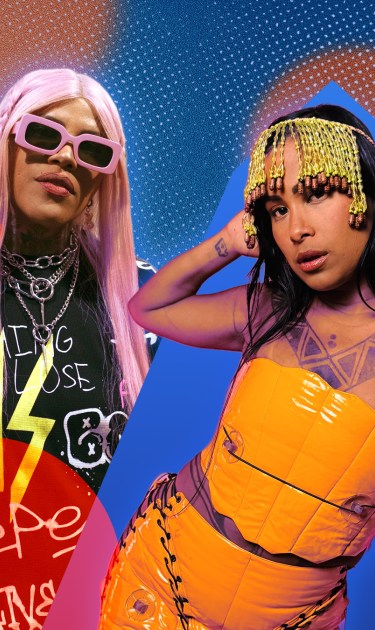When the singer Katú Mirim dropped “Bling Bling,” she used trap beats to critique gold exploitation in the Amazon rainforest. Like her, many indigenous artists across Brazil are reclaiming the spaces where they’ve never been welcome before. They’re on Spotify playlists, Grammy nomination lists, and major festival stages. They’re making trap, funk, and electronic music, and they’re doing it all without asking permission. For these artists, it’s about being sem vergonha, or sin vergüenza or shameless — unapologetic about who they are — with each taking a different approach at staking their place. We spoke to four Indigenous Brazilian artists about how they’re using contemporary music to preserve their cultures and claim space in Brazil’s mainstream music scene.
Mirim is Indigenous, Black, from the periphery, lesbian, punk — and she’s not toning any of it down. Growing up in São Paulo’s periphery in the ‘90s with a white evangelical family, she had no connection to her Indigenous roots. “People didn’t talk about Indigenous identity, and when they did, they had this idea that Indigenous people were savage and only lived in the forest,” she recalls. It wasn’t until she had internet access that she researched her people’s real history. Now, she uses that same digital space to flip the script. “When I come with this body of mine, saying that I wasn’t born in the village, that I’m a queer woman, with a punk, alternative style, I break with that imaginary and make people ask themselves who the Indigenous person is today,” she says.
In contrast, for Kaê Guajajara, it’s about building cultural bridges. She grew up far from her ancestral lands in Rio’s Maré favela, one of the city’s most violent areas in Brazil. She could have hidden her Indigenous identity to avoid discrimination, but instead made it central to her art. “Indigenous music is often put in a box that doesn’t contemplate our diversity, as if there were only one sound, one rhythm, one aesthetic for all peoples. I refuse this simplification,” she says. In practice, this means mixing maracá with electronic beats and singing in zeeg’ete, her native Guajajara dialect, over trap rhythms. It’s an approach that has worked for her. In 2024, she performed at Rock in Rio, bringing “Indigenous music, language, drums, and our aesthetic to a space that rarely sees us.” But it’s strategic: she’s proving Indigenous culture belongs on Brazil’s biggest stages.
But even in 2025, there’s still a long way to go, and that’s why MC Nhandewa takes yet another route: education through entertainment. The 20-year-old makes funk, switching between Portuguese and Guarani to teach both communities simultaneously. “I pass messages to my Guarani people and give vision to non-Indigenous people to understand our reality,” he explains. It’s intentional code-switching: he’s preserving language for his community when he raps in Guarani. And when he switches to Portuguese, he’s translating the same message and stories for mainstream Brazil. “I think rap teaches many words of encouragement to our people. The message that rap brings strengthens Indigenous blood even more, strengthens the family,” he says.

“Indigenous music is often put in a box that doesn’t contemplate our diversity, as if there were only one sound, one rhythm, one aesthetic for all peoples. I refuse this simplification.”
His collaboration with superstar DJ Alok, “Pedju kunumigwe,” earned a Grammy nomination in 2024, the first time an Indigenous Brazilian track reached that level. “It was important to show that we Indigenous people are conquering and demarcating space,” he says. Now, he wants to break into Brazil’s funk industry through GR6, the country’s biggest funk label.
While MC Nhandewa focuses on education and community strengthening, PJW’s approach is the most confrontational: he creates music as historical testimony. His father is Avá-Guarani, and his family was displaced when Brazil and Paraguay built the Itaipu dam in the 1970s, flooding Indigenous lands to create what was then the world’s largest hydroelectric plant, which still impacts the communities’ lives to this day. “My father always told stories about how it began. How the Itaipu people removed Indigenous people from there,” PJW recalls. His family was promised better land, but decades later, they’ve yet to receive anything. “Our village is very small. There’s no more forest to explore. Non-Indigenous people are planting corn and soy very close to our villages, and we suffer from a lot of pesticides.”
Rather than accept this quietly, PJW turned family trauma into political rap. He doesn’t have professional equipment (“I don’t have a studio yet, but I make do with what I have”), but his songs about environmental racism reach thousands online, like “PAREM DE NÓS MATAR” (“Stop Killing Us”) and “NAÇÃO INVADIDAS” (“Invaded Nations”).

These artists are just a few of the many others showcasing the diversity within Brazil’s Indigenous communities. The country has over 305 ethnic groups, speaking 180 languages, each with distinct cultures and challenges. What connects these artists isn’t shared tradition, but shared determination to control their own narratives.
That determination faces real obstacles. “The difficulties are really from lack of support, maybe prejudice, but mostly from lack of support to record the music,” admits MC Nhandewa. Brazil’s music industry has historically only seen Indigenous people as folkloric curiosities, not contemporary artists.
But these musicians aren’t waiting for industry acceptance. Kaê founded Azuruhu, her own label supporting Indigenous artists. “Autonomy is about being able to decide how, when, and with whom to tell our stories, without having to mold our art to fit market expectations,” she explains. Others are following similar paths. Djuena Tikuna modernizes traditional Tikuna songs, while Kaapora fuses Pataxó culture with electronic music, and Rapper Werá Jeguaka Mirim focuses on Indigenous rights activism. They’ve each found their own way to be heard.

What makes this movement significant isn’t just the music — it’s the refusal to choose between authenticity and evolution. For centuries, Brazilian Indigenous peoples faced a false choice: assimilate completely or remain frozen in an imagined past. However, these artists are refusing to conform to that restrictive binary.
Ultimately, it’s about preserving cultural legacies. “What I most want is for future generations to know: we were already here, dreaming for you. And that, when they look back, they feel that what we left wasn’t just art, but also love, courage and future,” says Kaê.
They’re not asking for permission to be heard, nor softening their message to make others comfortable. They’re making the music they want to make, talking about what matters to them, and letting the world catch up — without shame, without apology, exactly as they are.




